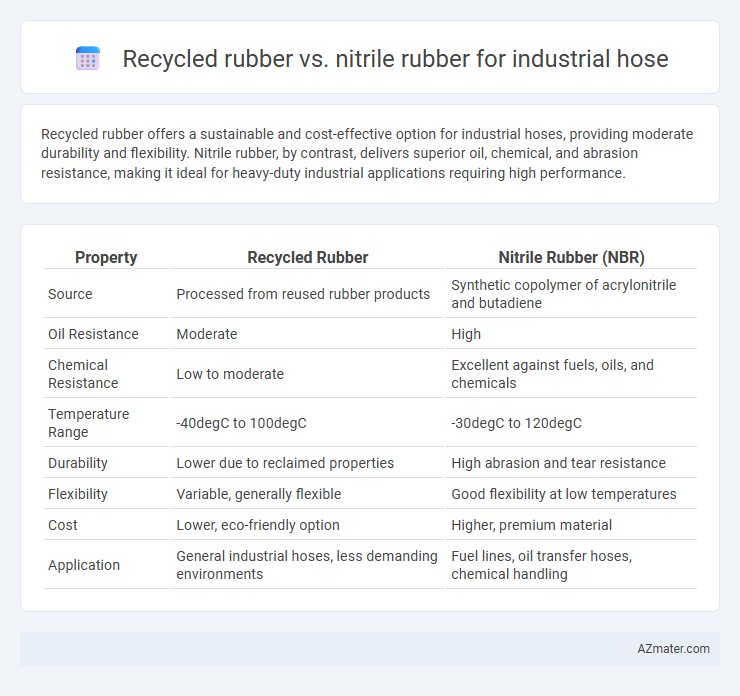Recycled rubber offers a sustainable and cost-effective option for industrial hoses, providing moderate durability and flexibility. Nitrile rubber, by contrast, delivers superior oil, chemical, and abrasion resistance, making it ideal for heavy-duty industrial applications requiring high performance.
Table of Comparison
| Property | Recycled Rubber | Nitrile Rubber (NBR) |
|---|---|---|
| Source | Processed from reused rubber products | Synthetic copolymer of acrylonitrile and butadiene |
| Oil Resistance | Moderate | High |
| Chemical Resistance | Low to moderate | Excellent against fuels, oils, and chemicals |
| Temperature Range | -40degC to 100degC | -30degC to 120degC |
| Durability | Lower due to reclaimed properties | High abrasion and tear resistance |
| Flexibility | Variable, generally flexible | Good flexibility at low temperatures |
| Cost | Lower, eco-friendly option | Higher, premium material |
| Application | General industrial hoses, less demanding environments | Fuel lines, oil transfer hoses, chemical handling |
Introduction to Industrial Hose Materials
Industrial hoses often utilize recycled rubber and nitrile rubber, each offering distinct advantages for specific applications. Recycled rubber is favored for its environmental benefits and cost-effectiveness, providing moderate resistance to abrasion and weathering. Nitrile rubber excels in industrial settings requiring superior chemical and oil resistance, particularly in fuel transfer, making it a critical material choice for durability and performance in harsh environments.
Overview of Recycled Rubber
Recycled rubber is derived from processed scrap tires and rubber products, offering an environmentally sustainable option for industrial hoses. It provides excellent abrasion resistance and cost-effectiveness, making it suitable for applications where durability and eco-friendliness are prioritized. While its chemical resistance is moderate compared to nitrile rubber, recycled rubber is favored for heavy-duty use in industries such as construction and agriculture.
Overview of Nitrile Rubber
Nitrile rubber, known for its excellent resistance to oils, fuels, and chemicals, is widely used in industrial hoses where durability and performance under harsh conditions are critical. Unlike recycled rubber, nitrile rubber provides superior tensile strength, abrasion resistance, and temperature tolerance, making it ideal for applications involving petroleum-based fluids and mechanical stress. Its molecular structure, featuring acrylonitrile and butadiene, enhances its impermeability and resistance to degradation, ensuring longer service life and reliability in demanding industrial environments.
Key Physical and Chemical Properties
Recycled rubber offers good abrasion resistance and flexibility but typically has lower chemical resistance and tensile strength compared to nitrile rubber, making it less suitable for aggressive fluids. Nitrile rubber excels in oil, fuel, and chemical resistance due to its high resistance to hydrocarbons, with superior tensile strength and excellent compression set properties, which extend hose durability in industrial applications. The choice depends on specific industrial demands, where nitrile rubber provides enhanced performance for handling oils and fuels, while recycled rubber suits less demanding environments with emphasis on sustainability.
Performance in Harsh Industrial Environments
Recycled rubber offers cost-effective durability but often lacks the chemical and abrasion resistance needed for demanding industrial hose applications. Nitrile rubber excels in harsh environments due to its superior resistance to oils, fuels, and hydrocarbons, maintaining flexibility and strength under extreme conditions. Industrial hoses made with nitrile rubber deliver longer service life and reliable performance in heavy-duty settings where recycled rubber may degrade prematurely.
Durability and Longevity Comparison
Recycled rubber hose offers moderate durability but may degrade faster under harsh industrial conditions compared to nitrile rubber, which is specifically engineered for superior resistance to oils, chemicals, and abrasion. Nitrile rubber hoses demonstrate exceptional longevity in environments with exposure to petroleum products and extreme temperatures, maintaining structural integrity and flexibility over extended periods. Choosing nitrile rubber significantly enhances hose lifespan and reduces maintenance costs, making it preferable for demanding industrial applications requiring robust durability.
Environmental Impact and Sustainability
Recycled rubber used in industrial hoses significantly reduces landfill waste and lowers the carbon footprint by reusing existing materials, promoting circular economy principles. Nitrile rubber, while offering superior resistance to oils and chemicals, is petroleum-based and less biodegradable, posing greater environmental concerns during production and disposal. Choosing recycled rubber enhances sustainability by minimizing resource extraction and environmental degradation in industrial applications.
Cost Analysis and Market Availability
Recycled rubber offers a cost-effective solution for industrial hoses due to lower material and production expenses, significantly reducing overall procurement costs compared to nitrile rubber. Nitrile rubber, known for its superior oil and chemical resistance, commands a higher market price but provides longer service life in demanding environments, justifying its premium cost in specialized applications. Market availability of recycled rubber is expanding with increased sustainability initiatives, while nitrile rubber remains widely accessible in industrial supply chains, ensuring reliable sourcing for various industrial hose requirements.
Typical Applications and Industry Suitability
Recycled rubber hoses are ideal for low-cost, eco-friendly applications such as agriculture, landscaping, and light construction where chemical resistance is less critical but flexibility and durability are required. Nitrile rubber hoses excel in oil, fuel, and chemical transfer industries, offering superior resistance to petroleum-based fluids, abrasion, and high temperatures, making them suitable for automotive, manufacturing, and industrial sectors. While recycled rubber suits general purpose and environmental applications, nitrile rubber is preferred for heavy-duty industrial uses requiring enhanced chemical compatibility and performance.
Choosing the Right Rubber for Industrial Hoses
Choosing the right rubber for industrial hoses depends on the application's requirements for durability, chemical resistance, and flexibility. Nitrile rubber offers superior resistance to oils, fuels, and abrasion, making it ideal for petroleum-based fluids and heavy-duty industrial environments. Recycled rubber provides an eco-friendly and cost-effective alternative but may lack the consistent chemical resistance and strength of nitrile, limiting its use in demanding industrial hose applications.

Infographic: Recycled rubber vs Nitrile rubber for Industrial hose
 azmater.com
azmater.com